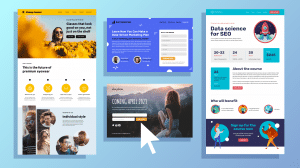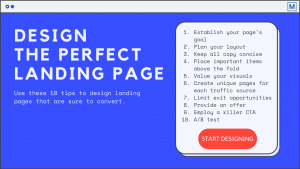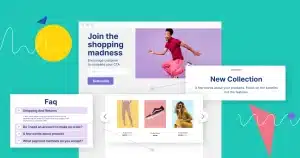How to Create Stunning Landing Page Designs
Introduction
A well-designed landing page can be a game changer for businesses looking to convert website visitors into loyal clients in the digital era. Because a landing page is the initial point of contact between a potential buyer and your brand, it is critical to make a good first impression. But how can you create landing page designs that capture your audience and compel them to act? In this post, we’ll look at the key components of developing good landing page designs that drive conversions and help you meet your business objectives.
Understanding Landing Pages
1. What is a Landing Page?
A landing page is a standalone web page that is created for a specific purpose, such as advertising a product, service, event, or generating leads. Landing pages, as opposed to standard internet pages, are designed to entice visitors to do a specific, targeted action, such as filling out a form, making a purchase, or signing up for a newsletter. They eliminate distractions that may divert visitors’ attention away from the intended action.

2. Importance of Landing Page Design
The design of your landing page is quite important in deciding its success. A visually appealing, user-friendly, and convincing design can boost your conversion rates dramatically. Visitors are more likely to trust and interact with a landing page that appears professional and is consistent with your brand identity.
Key Elements of a Landing Page
1. Clear and Compelling Headline
When visitors arrive at your page, the title is the first thing they see. It should be direct, unambiguous, and relevant to the offer or value proposition. Use persuading language that addresses the visitor’s pain points while emphasizing the benefits of doing the desired action.
2. Engaging Subheadings and Content
Subheadings that provide extra context and keep the visitor interested should be used to supplement your headline. Use persuasive and benefit-driven material to emphasize your product or service’s unique selling points. To boost readability, break up long blocks of text with bullet points and pictures.
3. Eye-Catching Visuals
Including relevant and high-quality visuals such as photographs, videos, or infographics can have a big impact on the efficacy of your landing page. Visuals can help you deliver complex information more effectively and connect with your audience emotionally. Check that the aesthetics are consistent with your brand and support the landing page’s messaging.
4. Call-to-Action (CTA)
The most important aspect of any landing page is the call to action. It should be visible and contain action-oriented wording to entice visitors to execute the intended action. To make the CTA button stand out from the rest of the page, use contrasting colors.

5. Trust Signals
Include trust signals such as customer testimonials, reviews, security badges, and endorsements to inspire trust and authenticity. Positive feedback from delighted customers can assist boost visitor confidence and inspire them to convert.
6. Mobile Responsiveness
With the increased use of mobile devices, it is critical that your landing page is fully responsive and optimized for different screen sizes. A mobile-friendly design ensures a consistent user experience regardless of the device.
Design Tips for Creating Landing Pages
1. Keep it Simple and Uncluttered
When it comes to landing page design, simplicity is crucial. Avoid overloading your visitors with needless information or components. A clean design keeps the attention on the offer and the call to action.
2. Use Contrasting Colors
Colors are significant in attracting attention and directing visitors’ focus to the most important aspects. To make the CTA button and essential headings stand out, use contrasting colors.
3. Maintain Consistent Branding
Keep your landing page design consistent with the overall appearance and feel of your business. This consistency strengthens brand identification and builds trust among your visitors.
4. A/B Testing
A/B testing is a strong tool for optimizing the design of your landing page. Make two versions of your landing page and test various aspects like as headlines, CTAs, and images to determine which one works better. This data-driven approach has the potential to significantly boost conversion rates. https://diversewebsitedesign.com.au/
5. Optimize Page Load Speed
A positive user experience requires fast-loading landing pages. Optimize picture sizes and code to guarantee your page loads quickly, lowering the danger of visitors abandoning it before seeing your offer.
Conclusion
Aesthetics, usability, and persuasion must all be considered when designing a good landing page. You can construct landing pages that captivate your audience’s attention and push them to take the necessary action by understanding the main aspects and using design best practices. To maximize conversion potential, remember to regularly monitor and optimize your landing pages based on user behavior and feedback. You may catapult your organization to greater success and growth in the digital realm with a well-designed landing page. https://livein.solutions/ceiling-repairs-perth/







